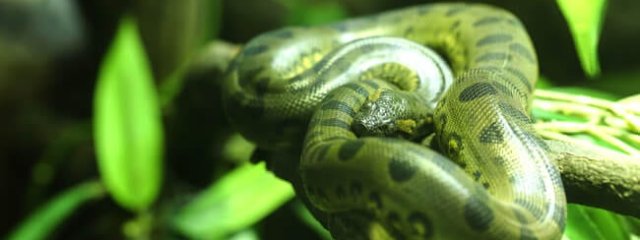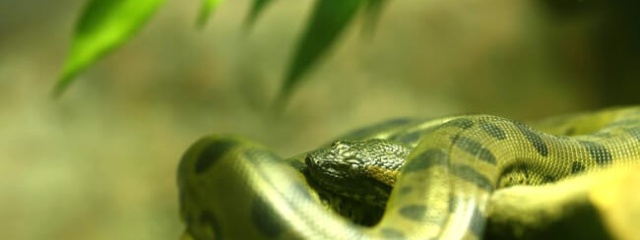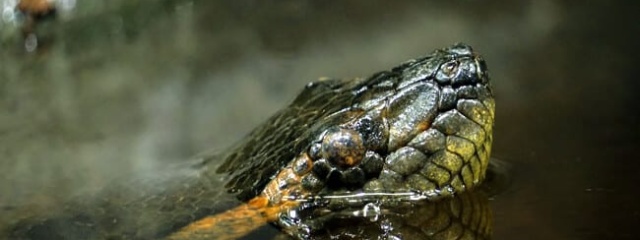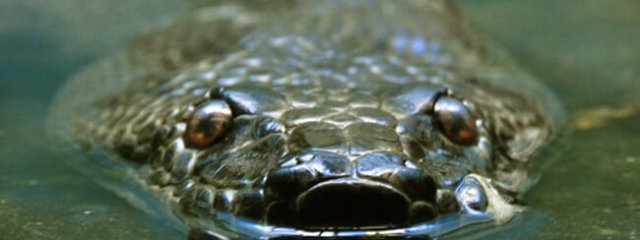Green anacondas are incredibly large snakes native to the forests of South America. They are also known as “common anacondas,” or “water boas.” Though they are not the longest officially recorded snake, they could potentially be the longest snake in the world according to unverified reports. Read on to learn about the green anaconda.
Description of the Green Anaconda
Would you be surprised if you were told that green anacondas are… green? While they aren’t neon green or anything of the sort, they are a muddy green that blends in to the turbid waters of the Amazon and other South American rivers. Their scales are also blotched with black spots that help them camouflage themselves. They are the largest snakes in the Americas, but their maximum size is highly debated.
Interesting Facts About the Green Anaconda
These massive snakes are incredibly adapted creatures. Though they are rather slow on land, not unusual considering their incredibly large bodies, they are at home in the water. Learn more about these skilled predators below.
- Just How Big? – Scientists aren’t quite sure just how large these snakes can grow, namely because they live in the murky waters of the South American rainforest. It is difficult to verify claims, because the skins can be stretched after death, and dragging the Guinness Book of World Records hundreds of miles up the Amazon while keeping a snake alive is less than practical.
- So… Just How Big? – Basically, no one is sure. There are a number of unverified reports that suggest these snakes can be ridiculously long. One discovered in 2016 was reported to be 33 ft. long. Many other sightings report snakes between 20 – 30 ft. long.
- Water Boa – Anacondas are at home in the water, and utilize it frequently to hunt prey. They can stay submerged for at least ten minutes at a time before coming up for a breath. In order to remain stealthy, even when they have to breathe their nostrils and eyes are poised on the top of their head. This means that a very small portion of their body is visible while they breathe.
- Not the Most Distinguishing Palate – Females of this species are longer, heavier, and stronger than males are. Unfortunately for the males, if the female doesn’t find him up to par for breeding standards she will take a shot at making him her next meal! It is not unusual for these reptiles to participate in cannibalism.
Habitat of the Green Anaconda
The most common habitats for these reptiles are rivers meandering through tropical rainforest. They are native to streams, rivers, river basins, wetlands, marshes, and swamps.
The vast majority of their time is spent in the water, mainly because they are capable of much easier movement while swimming. They are quite cumbersome on land, but can travel virtually unnoticed in the water.
Distribution of the Green Anaconda
This snake’s habitat spans across much of South America east of the Andes Mountains. They are found as far south as Paraguay and as far north as Venezuela and Columbia. Other common sighting locations include Brazil, Ecuador, Trinidad, Peru, Guiana, and Bolivia. Virtually any waterway east of the Andes Mountain range is fair game.
Diet of the Green Anaconda
Anything that wanders close enough to this predator’s mouth is in danger of being eaten, including very large creatures. Instead of using venom to subdue their prey, they have backwards facing fangs and utilize constriction to slowly suffocate their prey. Large prey, like tapirs, caimans, deer, jaguars, and capybaras, are eaten, but not frequently. Smaller mammals, reptiles, fish, and birds, are more commonly consumed.
Green Anaconda and Human Interaction
As you may expect with such a massive predator, tales of human consumption are somewhat prevalent. Though local legends may paint these reptiles as man-eaters, there is actually very little evidence to suggest they hunt humans.
Like most species, humans pose a greater threat to them than they do to us. As you may guess based on the fact that scientists have been unable to verify their maximum length, we do not know how healthy their population is. Habitat destruction and deforestation could be a major problem to this species.
Domestication
These snakes have not been domesticated in any way.
Does the Green Anaconda Make a Good Pet
Besides their length making them an incredible danger, this species is difficult to house. Not only do you have to provide a large enough habitat, but that habitat must also have a water source for them to fully submerge themselves in. In essence, no they would not make good pets.
Green Anaconda Care
As discussed above, an appropriately large habitat with an equally large water source is absolutely necessary. A heating source with a temperature gradient, and high humidity is also required for these reptiles to stay healthy in human care. Their diet is similar to other large reptiles, and includes rats, rabbits, chickens, and more, depending on the facility.
Behavior of the Green Anaconda
Anacondas are nocturnal creatures, which means they are most active at night. At home in the water, they will rarely come onto land because they are unable to move quickly. Most of their time is spent floating beneath the surface of the water, with only their eyes and nostrils at the surface. They can be surprisingly fast in the water, and will lie in ambush until prey comes within striking range.
Reproduction of the Green Anaconda
Scientists believe that males locate females using scent, but are unsure just how this occurs. Males will all attempt to breed with the female, and can wrestle with one another while wrapped around the female for as long as four weeks!
The female has a gestation period of 6 or 7 months, and gives live birth to as many as 100 young, but 20 – 40 is more common. Generally speaking, the larger the snake the more young she will produce. Once the young snakes are born they are self sufficient, and receive no maternal care.













![Red Angus Closeup of a beautiful Red Angus cowPhoto by: U.S. Department of Agriculture [pubic domain]https://creativecommons.org/licenses/by/2.0/](https://animals.net/wp-content/uploads/2020/03/Red-Angus-4-238x178.jpg)












![Red Angus Closeup of a beautiful Red Angus cowPhoto by: U.S. Department of Agriculture [pubic domain]https://creativecommons.org/licenses/by/2.0/](https://animals.net/wp-content/uploads/2020/03/Red-Angus-4-100x75.jpg)

